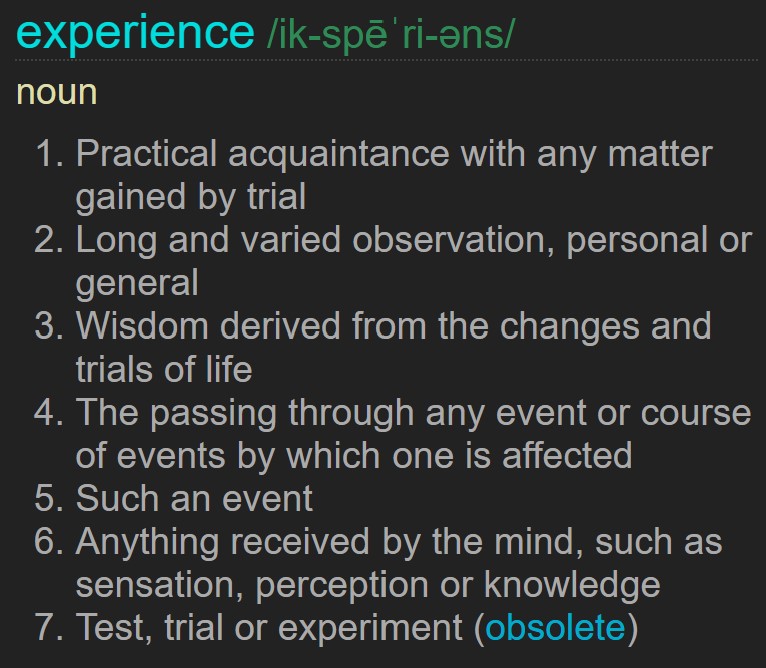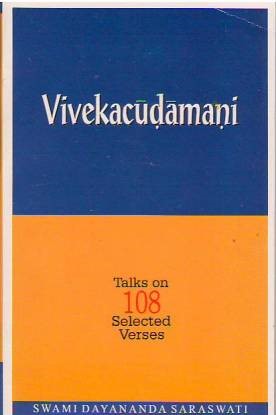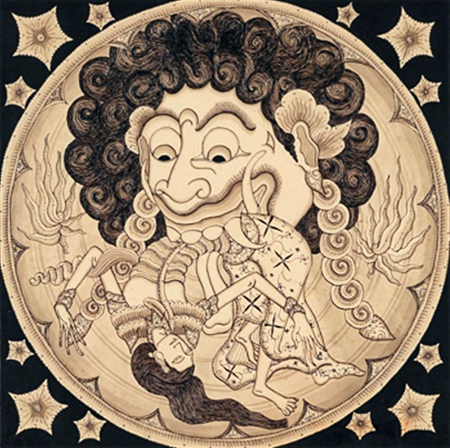Here are the definitions for the word ‘experience’ in Chamber’s dictionary:


Q: I am reading your book ” Confusions in Advaita Vedanta”.
I am from India, born in the Smarta Brahmin tradition of The revered Adi Shankara.
The purport of Adi Shankara as repeatedly explained by you is that no pramana or meditation except shabda pramana, teaching of scripture expounded by qualified teacher can give jnana. And this understanding happens in the process of listening once. Repetitions don’t help.
This caused both enthusiasm and later negativity in me. I have heard scriptures being expounded by Swami Dayananda, Swami Paramarthananda, Swami Brahmananda, Swami Parthasarathy, Sri Gangolli (translator of Swami Satchidananendra) etc. But no understanding or Jnana has resulted.
Am I doomed? Or Does it mean I was not qualified enough? More yoga sadhana required for purifying my mind? Of course there can be no doubt that the teachers were qualified. So fault is mine.
Martin,
Your post made me realize that I have rarely, if ever, encountered any definition/explanation of the concept of time in Advaita. It set me off on a search of my library to try to find something. Apart from those books which index every word they contain (e.g. Krishnaswamy Iyer’s ‘Vedanta or the Science of Reality’ has 107 page-references to ‘time’), I could not find anything in any of my physical books. A search of my electronic database came up with very few references and the only scriptural one I could find is from Vivekachudamani 497:
sthulādibhāvā mayi kalpitā bhramā-dārōpitānusphuraṇena lōkaiḥ |
kāle yathā kalpakavatsarāya-ṇartvā dayō niṣkalanirvikalpe ||497||
John Grimes translates:
Sthūlādi = gross and so on; kalpita bhramāt = erroneously imagined; āropitānu-sphuraṇena = manifestation superimposed; kale = time; kalpaka = eons; vatsarāyaṇa = years and half-years; ṛtvādi = seasons and so on.
Continue readingAnother review from 10+ years ago at Advaita Academy. I have amended this to bring it up to date.

Vivekachudamani (vivekachUDAmaNi), Swami Dayananda Saraswati, Sri Gangadadharesvar Trust, 1997, No ISBN. (312 pages), $12 from Arsha Vidya Bookstore, Arsha Vidya Gurukulam, Institute of Vedanta & Sanskrit, P.O. Box 1059, Saylorsburg, Pennsylvania, 18353, USA Tel: 570.992.2339 (http://books.arshavidya.org/) The book is in English. Verses are given in Devanagari, followed by transliteration and then word by word translation. Direct Devanagari quotations from other sources are provided in footnotes.
Continue reading

The scriptures utilize many stories and metaphors to coax the mind towards an understanding of Brahman – after all, this is one of the few ways this can be done since Brahman cannot be described. One that is rarely encountered is the myth of rAhu.
According to Monier-Williams (Ref. 179), the word ‘rAhu’ means ‘the Seizer’. It refers to a story in the Hindu purana-s (sacred books of mythology and cosmology), although the myth also occurs in much older Buddhist texts. The fable has the gods ‘churning’ the ocean in order to extract the ‘nectar of immortality’ (amRRita). One of the demons who are watching this, disguises himself, steals a portion and drinks it, thereby becoming immortal too. The sun and moon gods witnessed this and told Vishnu, who subsequently cut off the demon’s head. The head became known as rAhu and the rest of the body (with the tail of a dragon) as ketu. They were then evicted from the earth, from where rAhu continually tries to wreak revenge on the sun and moon by eating (‘seizing’) them. We see these attempts when eclipses take place. Continue reading
While the body-mind remains alive (i.e. continues to be animated by Consciousness), the person is a mixture, as it were, of both. If I am enlightened, I know that I am really the original Consciousness, Brahman, but I cannot escape the fact that I am also still a jIvAtman, with that same Consciousness reflecting in the intellect. If I am unenlightened, I either do not know about paramAtman or do not believe that this is who I really am. Instead, I identify with body, mind, attributes or functions. I mistakenly superimpose (adhyAsa) the properties of the mithyA body-mind onto the paramAtman.
The same applies even to ‘knowing’. When we say ‘I know’, whether or not we are enlightened, it has to be the reflected ‘I’ that is speaking. Shankara says in his bhAShya on Bhagavad Gita 2.21:
“ …the Self, though verily immutable, is imagined through ignorance to be the perceiver of objects like sound etc. presented by the intellect etc.; in this very way, the Self, which in reality is immutable, is said to be the ‘knower’ because of Its association with the knowledge of the distinction between the Self and non-Self, which (knowledge) is a modification of the intellect and is unreal by nature.” (Ref. 6)
Thus, it can be seen, that this provides an explanation for the fact that I may be enlightened and yet the mind can still be affected by pratibandha-s. It there are none, because the mind was purified prior to enlightenment, then I am a jIvanmukta, enjoying all of the benefits of a mind unsullied by negative emotions. Otherwise, I must continue to perform those sAdhana-s that will eliminate such tendencies before I can reap the ‘fruits’ of enlightenment, j~nAna phalam. Whilst both are still inevitably a ‘mixture’, the one with pratibandha-s still says ‘I’ with a significant element of jIvAtman; the one who has purified the mind says ‘I’ with a predominant element of paramAtman. Continue reading
Shankara differentiates what might be called ‘ordinary’ or ‘intellectual’ knowledge (j~nAna) from ‘transformative’ knowledge (vij~nAna). The knowledge becomes transforming – i.e. making it efficacious in conveying the status of jIvanmukti – when the gaining of it has been preceded by successful sAdhana chatuShTaya sampatti. In his bhAShya on muNDaka upaniShad 2.2.8, he says:
“Wise, discriminatory people (dhIrA) see through vij~nAna; vij~nAna is a special (vishihtena) knowledge (j~nAna), born out of the teaching of shAstra and AchArya (shAstra AchArya upadesha janitam), and received in a specially prepared mind, born (udbhutena) out of total detachment (vairAgya), having control of inner and outer organs (shama and dama), and which is therefore capable of upAsanA to begin with and later of nididhyAsana which together are called meditation (dhyAna). Through such a vij~nAna, wise people realize that the nature of the Atman (Atmatatvam) is non-different from the nature of Brahman (brahmatatvam)…” (Ref. 10)
Who are we speaking of when we use the words ‘I’ and ‘you’ in writing and speech?
Since we are Advaitins, there are actually three possibilities:
nididhyAsana is recommended to remove any mental impediments that remain. This may consist of any activity that serves to consolidate the knowledge and fully assimilate the teaching – e.g. reading scriptures, listening to talks from qualified teachers, writing about Advaita oneself, discussing with other seekers and so on. The logic is simple: these activities produce puNya karma which ‘cancels out’ the pratibandha-s.
The vivekachUDAmaNi (267 – ) speaks about this at length:
“Even after knowing that substance (the Atman), powerful desire, which is beginningless (in the form of ‘I am the doer and enjoyer’), which is the cause of the world, does not die. It remains there. What can be done with that? You must do away with that desire carefully, because that is freedom – the lessening of desire. That should be done even after realization.
“The idea of ‘me’ and ‘mine’ remains in the body and in other things that are non-Self. This is called adhyAsa, and should be given up by the sage identifying himself with the Atman.
“Knowing the real Self, which is the witness of the intellect and its actions, by this thought, ‘I am That’, conquer the false idea of ‘I am’ in the non-Self.
“First, give up following the world, then following the body, and then following the scriptures and, in that way, do away with your ignorance of identifying the Self with the non-Self.” and so on… (Ref. 62)

The original metaphor seems to come from the Taittiriya Upanishad. (It is also outlined in the Sarva-Sara Upanishad and the Paingala Upanishad.)
Here are some extracts from Swami Nikhilananda’s translation of the Taittiriya:
II.1.3. From the Atman was born AkAsha; from AkAsha, air; from air, fire; from fire, water; from water, earth; from earth, herbs; from herbs, food; from food, man. He, that man, verily consists of the essence of food. This indeed is his head, this right arm is the right wing, this left arm is the left wing, this trunk is his body, this support below the navel is his tail.
II.2.1. Verily, different from this, which consists of the essence of food, but within it, is another self, which consists of the vital breath. By this the former is filled. This too has the shape of a man. Like the human shape of the former is the human shape of the latter. prANa, indeed, is its head; vyAna is its right wing; apAna is its left wing; AkAsha is its trunk; the earth is its tail, its support. Continue reading
In his comments on the post ‘SamAdhi Again (Part 2)‘, Venkat said: “Dayananda has nothing useful to say about realisation. All of his statements are his mundane interpretations that don’t reconcile to anything that the great masters from Gaudapada and Sankara have said.”
And “Could you provide a couple of quotes from Sankara to support your Dayananda comment:
“Therefore, the knowledge is that I am thoughtfree (nirvikalpa) in spite of the experience of vikalpa . . . mithyA is not a problem – it is useful; mind is useful and that is all there is to it””
This attitude was also supported by Shishya in his comment on the same post: “I think Venkat put it very well.”
Accordingly, I have collected together a number of quotations that support the contention that only knowledge (and not action or samAdhi etc.) produces enlightenment; that ‘enlightenment’ is nothing other than Self-knowledge arising in the mind; and that the mind continues after enlightenment. These quotations demonstrate that those readers who have been criticising Swami Dayananda and his followers have been doing so unjustly.
*****
2.21
“(Similarly) the same Self, which is in reality beyond all changes of state, is called ‘enlightened’ on account of discriminative knowledge separating the Self from the not-self, even though such knowledge is only a modification of the mind and illusory in character (and implies no real change of state).
2.56
“Moreover that monk (i.e. man of realization) is then called a man of steady wisdom; when his mind is unperturbed; when his mind is unperturbed by the sorrows that come on the physical or other planes; …and has gone beyond attachment, fear and anger.
and BG 2.55 says that a stitha praj~na is a man who drives away all desires that crop up in the mind. Continue reading